博文
华中科技大学开发出触摸生电的透明纳米纸(附原文)
|||
华中科技大学开发出触摸生电的透明纳米纸(附原文)
诸平

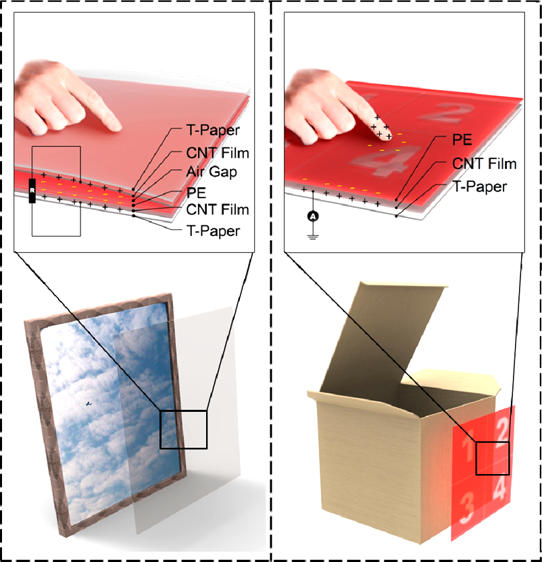
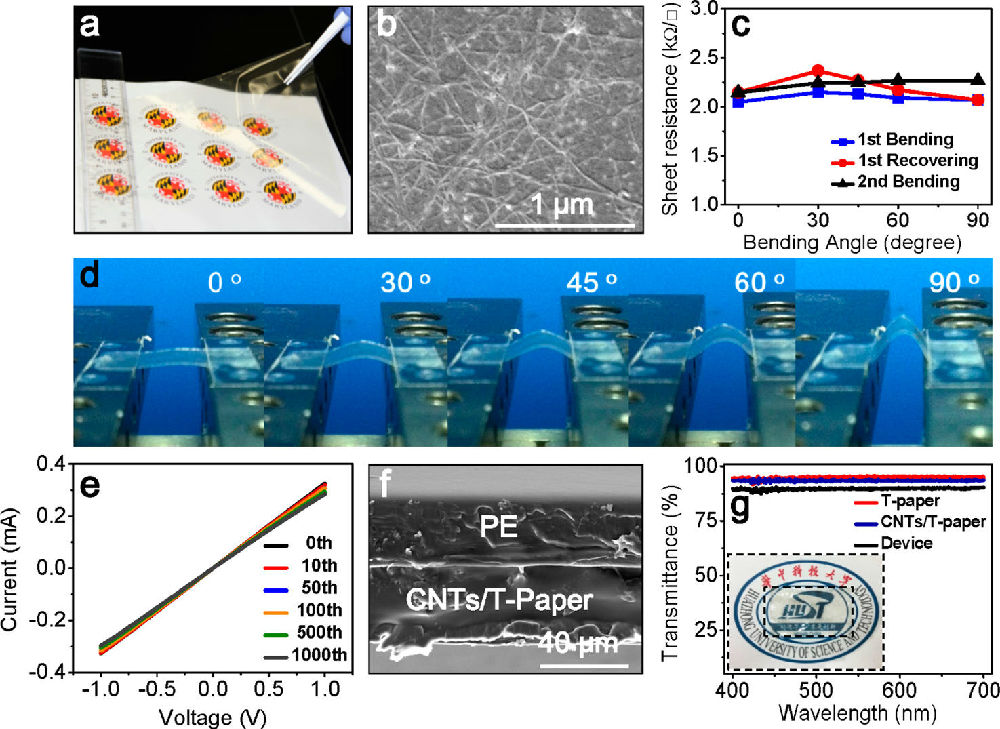
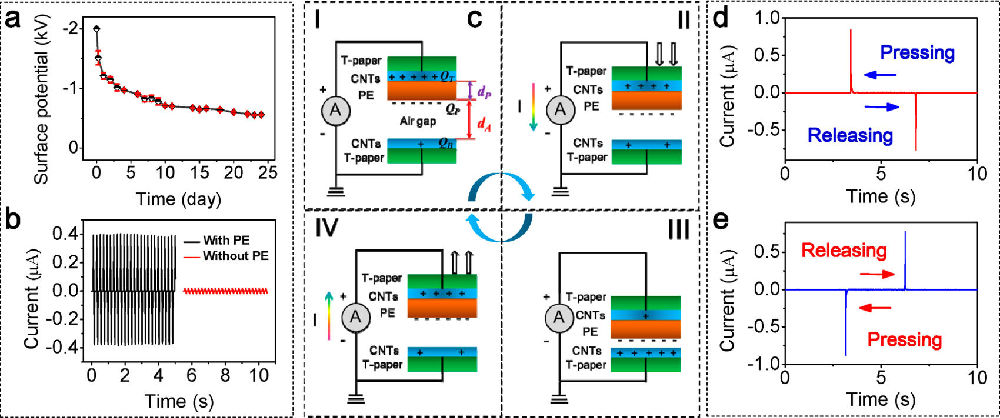
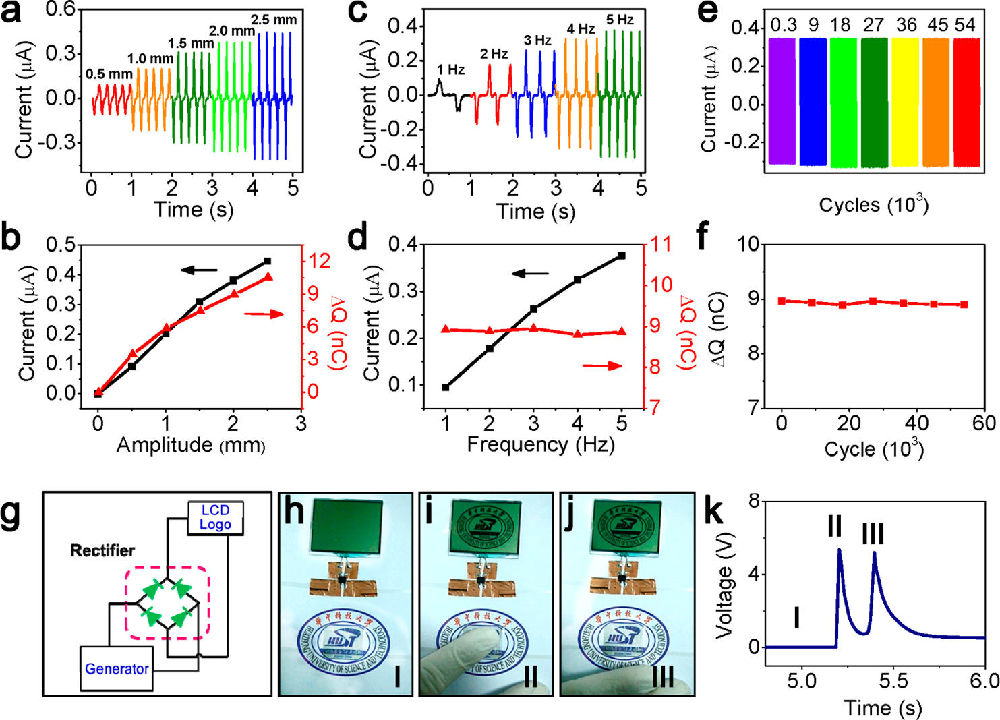
点击“Self-Powered Human-Interactive Transparent Nanopaper Systems”
可以免费下载原文。
据《化学与工程新闻》(C&EN)网站2015年7月14日报道,华中科技大学武汉国家光电实验室及光电信息学院(Wuhan National Laboratory for Optoelectronics, and School of Optical and Electronic Information, Huazhong University of Science and Technology)周军教授等人与美国马里兰大学材料科学与工程系(Department of Materials Science and Engineering, University of Maryland)的研究人员合作,研发出一种用手指触摸即可产生电流的透明纳米纸。以纳米纸为基础的能量采集器,可能导致廉价、可再生触摸传感器和电子设备。下面的图示就是一个纸动力显示系统,当手指按下时, 由手指下面的透明纳米纤维纸构成的发电机,即可产生足够的电流来使上面的一个小液晶显示器显示一个华中科技大学的徽标。
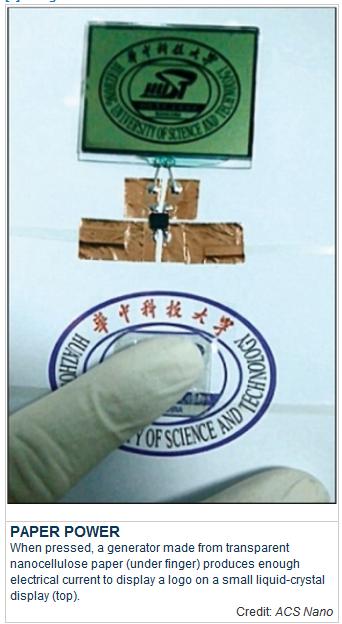
此项轻轻触摸即可产生电力的新透明纳米纸研究成果,2015年6月29日已经在美国化学会主办的ACS Nano杂志网站发表——Junwen Zhong, Hongli Zhu, Qize Zhong, Jiaqi Dai, Wenbo Li, Soo-Hwan Jang, Yonggang Yao, Doug Henderson, Qiyi Hu, Liangbing Hu, Jun Zhou. Self-Powered Human-Interactive Transparent Nanopaper Systems. ACS Nano, DOI: 10.1021/acsnano.5b02414. Publication Date (Web): June 29, 2015. 点击论文标题可以免费下载原文
研究人员说,这种纸式的能量采集器可以用来制作可以任意处理的、褶皱性的自供电触摸屏、互动式的发光书籍、修补术相当敏感的皮肤、以及艺术和文档的安全系统等。关于纸电子产品的研究,在过去的十年里对由可再生资源构成的轻便、灵活、低成本的设备,就已经给出了其诱人的前景,目标是使用纸作为电路版来取代玻璃或塑料。
对于高质量的电子产品而言,人们转向纳米纸,是由纤维素纳米纤维构成的纠缠在一起的复杂垫子,而不是在普通纸里可以看到的微米大小的纤维。这些极小的纤维可以使纳米纸变得透明,也可以使其光滑的如同塑料一样,是电路电子材料适合的涂覆超薄层的典范。有不少研究团队已经在纳米纸上制得了有机发光二极管、晶体管和天线,但是这些设备需要一个外部电源。
马里兰大学的胡良斌(Liangbing Hu )和我国华中科技大学的周军(Jun Zhou)及其同事,要制造出与众不同的纳米纸产品,不是需要外加电源,而是自供电的纳米纸产品。因此,他们设计了一种以纳米纸为基础的,能够将机械能转化为电能的发电机。更多信息请浏览原文。
C&EN报道摘引如下:
Web Date: July 14, 2015
Transparent Paper Produces Power With Just A Touch
News Channels: Materials SCENE, Nano SCENE
Keywords: nanopaper, transparent electronics, cellulose, energy harvester, generator, flexible electronics

A new transparent-paper device can generate electrical power from a user’s touch (ACS Nano 2015, DOI: 10.1021/acsnano.5b02414). The paper energy-harvester could be used to make disposable, self-powered touch screens that fold; interactive light-up books; touch-sensitive skin for prosthetics; and security systems for art and documents, the researchers say.
Research on paper electronics has taken off in the past decade given their promise for light, flexible, low-cost devices made from a renewable resource. The goal is to use paper as a substrate for circuits instead of glass or plastic.
For high-quality electronics, people have turned to nanopaper, a tangled mat made of cellulose fibers that are nanometers wide, instead of the micrometer-sized fibers found in regular paper. The tinier fibers make nanopaper transparent. They also make it smooth like plastic, ideal for depositing ultrathin layers of electronic materials for circuits. Various teams have made organic light-emitting diodes, transistors, and antennae on nanopaper. But these devices needed an external power source.
Liangbing Hu of the University of Maryland; Jun Zhou of Huazhong University of Science & Technology, in China; and their colleagues wanted to make nanopaper electronics self-powered. So they designed a nanopaper-based generator that converts mechanical energy into electrical power.
To make the device, the researchers used carbon nanotubes to coat two sheets of nanopaper, which served as a pair of electrodes. Then they coated one of the nanotube films with a 30-μm-thick film of polyethylene (PE) and pressed the edges of the two sheets together, sandwiching the PE in the middle and leaving a tiny air gap between the sheets. Before making the sandwich, they subjected the PE film to a high-voltage electric field, which injected it with extra electrons and made it negatively charged. This induces balanced positive charges on the nanotube film surfaces next to the PE.
The generator operates via electrostatic induction. Pressing the device narrows the air gap, bringing the PE-coated electrode closer to the other electrode, increasing the positive charge on that electrode. This change in charge balance between the nanotube electrodes results in a flow of current through the device. Releasing the pressure causes electrons to flow back, so repeated pressing and releasing creates continuous current.
The device is robust, producing a steady current for more than 54,000 press-release cycles. The researchers reported that pressing a 2- by 2-cm generator produced enough current to light up a small liquid-crystal display.
Because of the device’s transparency, the researchers propose its use in security and anticounterfeit systems for valuable paintings and documents. For instance, a sensor patch fixed on a painting could trigger an alarm when someone touches it. The team imagines other applications as well. “This device is invisible, and it’s powered by human finger,” Hu says. “So you could make any document, toy, or book interactive.” Zhou adds that his group plans to extend the technology for electronic skin.
Although a team at Georgia Institute of Technology has made similar transparent energy-harvesting sensors before, those devices were made of plastic and relied on static electricity. This is the first demonstration of a transparent self-powered generator made from paper, “definitely a significant advance,” says Zhenqiang (Jack) Ma, an electrical engineer at the University of Wisconsin, Madison. “The system is very attractive for massive production and eventually environment-friendly disposal. It paves the way toward manufacturable smart-paper electronics.”
https://wap.sciencenet.cn/blog-212210-906564.html
上一篇:SCImago 2014收录中国高校学报95种,中矿大1,西南石油大2,浙大
下一篇:祝卅年学友聚会圆满成功